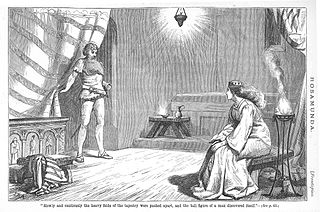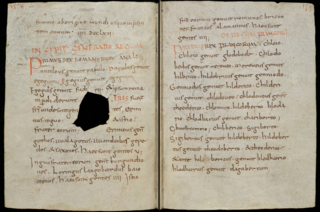
Alboin was king of the Lombards from about 560 until 572. During his reign the Lombards ended their migrations by settling in Italy, the northern part of which Alboin conquered between 569 and 572. He had a lasting effect on Italy and the Pannonian Basin; in the former his invasion marked the beginning of centuries of Lombard rule, and in the latter his defeat of the Gepids and his departure from Pannonia ended the dominance there of the Germanic peoples.

Childeric III was King of the Franks from 743 until he was deposed in 751 by Pepin the Short. He was the last Frankish king from the Merovingian dynasty. Once Childeric was deposed, Pepin became king, initiating the Carolingian dynasty.
Alex Woolf is a British medieval historian and academic. He specialises in the history of Britain and Ireland and to a lesser extent Scandinavia in the Early Middle Ages, with a particular emphasis on interaction and comparison across traditional ethnic boundaries. He is a senior lecturer at the University of St Andrews.
Peter John Heather is a British historian of late antiquity and the Early Middle Ages. Heather is Chair of the Medieval History Department and Professor of Medieval History at King's College London. He specialises in the fall of the Western Roman Empire and the Goths, on which he for decades has been considered the world's leading authority.

The Limes Saxoniae, also known as the Limes Saxonicus or Sachsenwall, was an unfortified limes or border between the Saxons and the Slavic Obotrites, established about 810 in present-day Schleswig-Holstein.

Walter Pohl is an Austrian historian who is Professor of Auxiliary Sciences of History and Medieval History at the University of Vienna. He is a leading member of the Vienna School of History.
Walter Andre Goffart is a German-born American historian who specializes in Late Antiquity and the European Middle Ages. He taught for many years in the history department and Centre for Medieval Studies of the University of Toronto (1960–1999), and is currently a senior research scholar at Yale University. He is the author of monographs on a ninth-century forgery, late Roman taxation, four "barbarian" historians, and historical atlases.
Charles Patrick Wormald was a British historian born in Neston, Cheshire, son of historian Brian Wormald.

Dick Walther Harrison is a Swedish historian. He is currently a Professor of History at Lund University.
The Vidivarii are described by Jordanes in his Getica as a melting pot of tribes who in the mid-6th century lived at the lower Vistula:
Ad litus oceani, ubi tribus faucibus fluenta Vistulae fluminibus ebibuntur, Vidivarii resident ex diversis nationibus aggregati.

Helmichis was a Lombard noble who killed his king, Alboin, in 572 and unsuccessfully attempted to usurp his throne. Alboin's queen, Rosamund, supported or at least did not oppose Helmichis' plan to remove the king, and after the assassination Helmichis married her. The assassination was assisted by Peredeo, the king's chamber-guard, who in some sources becomes the material executer of the murder. Helmichis is first mentioned by the contemporary chronicler Marius of Avenches, but the most detailed account of his endeavours derives from Paul the Deacon's late 8th-century Historia Langobardorum.
Thurisind was king of the Gepids, an East Germanic Gothic people, from c. 548 to 560. He was the penultimate Gepid king, and succeeded King Elemund by staging a coup d'état and forcing the king's son into exile. Thurisind's kingdom, known as Gepidia, was located in Central Europe and had its centre in Sirmium, a former Roman city on the Sava River.
Turismod was a son of the king of the Gepids Thurisind. He was killed in 551 or 552 on the battlefield by Alboin, son of the king of the Lombards Audoin.
The Nahanarvali, also known as the Nahavali, Naha-Narvali, and Nahanavali, were a Germanic tribe mentioned by the Roman scholar Tacitus in his Germania.
Hudhayfa ibn al-Ahwas al-Qaysi was the eighth governor of al-Andalus under the Umayyad caliphate of Damascus. He served for six months in the year AD 728.
Uthman ibn Abi Nis'a al-Khath'ami was the ninth governor of al-Andalus for the Umayyad Caliphate. He governed for four months from late AD 728 until early 729 (111), succeeding Hudhayfa ibn al-Ahwas al-Qaysi.
Muhammad ibn Abd Allah al-Ashja'i was the eleventh governor of al-Andalus under the Umayyad Caliphate in AD 730. He was one of a series of Arabs from Ifriqiya who served as governors in al-Andalus from 721 to 731.

Mayke de Jong is a Dutch historian and Professor Emerita of Medieval History at Utrecht University. Her research focuses on the political and religious history of the early Middle Ages.
The Vienna School of History is an influential school of historical thinking based at the University of Vienna. It is closely associated with Reinhard Wenskus, Herwig Wolfram and Walter Pohl. Partly drawing upon ideas from sociology and critical theory, scholars of the Vienna School have utilized the concept of ethnogenesis to reassess the notion of ethnicity as it applies to historical groups of peoples such as the Germanic tribes. Focusing on Late Antiquity and the Early Middle Ages, the Vienna School has a large publishing output, and has had a major influence on the modern analysis of barbarian identity.

The Frankish Table of Nations is a brief early medieval genealogical text in Latin giving the supposed relationship between thirteen nations descended from three brothers. The nations are the Ostrogoths, Visigoths, Vandals, Gepids, Saxons, Burgundians, Thuringians, Lombards, Bavarians, Romans, Bretons, Franks and Alamanni.